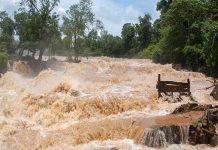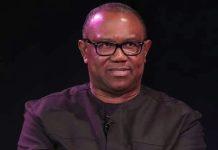
Big Flood 2022, never seen in this part of the world in living human memory or captured in the historical data, visited Nigeria unhindered, especially Bayelsa and the rest of the low-lying areas. Now gradually, effortlessly ebbs away, its trail on many, especially the people whose natural habitat are the flood plains or swamplands. There have been lamentations, wailing and gales of funerals. Life must go on, so the survivors from north to south are rising to restart lives from the scratch.
That natural disasters occur, is a very sordid reality of human existence. From the study of history, archaeology and earth sciences, we have come to know that the world which we know is a product of millions of years of cataclysmic disasters, especially geological (earthquakes, volcanos) and hydrometeorological (floods, tsunamis and strong winds) over time. Some other disasters have been biomedical (plagues).
I attended my first United Nations hosted COP Meeting in Copenhagen, Denmark in one of the coldest winters ever in 2009. As Nigeria’s Ambassador to the Nordic Countries (Denmark, Norway, Sweden and Finland), I was privileged to host the slightly exaggerated Nigerian delegation of 2,000 participants, next to only China. Sadly, the heroes of the Nigerian squad at the Danish capital in that historic outing, including President Umaru Musa Yar’Adua, (who stood down to take care of his health in Saudi Arabia), John Odey, perhaps the best Environment Minister the country ever had, the ultra eclectic Ojo Madueke, then Foreign Minister, the princely Rilwanu Lukman, Petroleum Minister of the day, even Muhammad Barkindo, GMD of NNPC at the time have all gone to rest. It was the largest gathering ever with over 120 Heads of States from 193 countries. It was, hoped by all to be the tie-breaker to save mother earth. Alas, COP15 ended in deadlock, though a mammoth $100 billion a year of support for climate-resilience related funding was pledged. Thereafter, the gatherings moved from city to city, including to Rio, Paris and penultimately to Glasgow.
Just rising from Sharm El Sheik with other 50,000 delegates and listening to the cacophony of sugar-coated diatribes of high political authorities at the High-Level Plenaries and the energising rigour of scientific sessions, it is obvious that we still have a long way ahead. No wonder, already, Dubai has hurriedly secured for itself the hosting rights for the climate parleys, now something similar to World Cup or Olympic Games, for COP28.
The question is QUO VADIS??? Especially for humanity, for the fast-warming earth, for the melting glacier ice, for the rising sea levels, for the drowning Island nations, for the coastal regions and for the sinking deltas.
With the big political guns all jetting out of the picturesque conference hub on Egypt’s Mediterranean coast, a spectre of disillusionary reflections cast an ominous foreboding on recovering from Flood 2022. So, will these waters come again? Will so many people die or get injured or get bitten by fleeing reptiles? Will the entire Bayelsa State for one, again soon remain under water for two months? Will people in my Southern Ijaw Local Government Area, the most southerly and deltaic frontier of Nigeria again live in their canoes for several weeks? Will the cries of hurting families, the groaning of the aged and pregnant women and others be heard by anyone if something happens again?
I recently stirred the hornet’s nest as I consider myself and rightly so too, as an older and more senior public servant, ready to offer some advice. It might be late as you may be already preparing to leave government in a matter of months, but these reflections may help others like you. Particularly, those who find themselves at the centre in Abuja entrusted with unbelievably sensitive responsibilities and gargantuan budgets, but possess limited experience, skills and exposure. I had the trust of giving you counsel, I might still glean and regurgitate on these few words.
HOW FLOODS OCCUR.
Will floods occur, yes, every year!
Following the rainfall cycle well released by the relevant agencies, the heaven’s gates starting opening up from late May, 2022, peaking in late September. From caway Guinea Highlands, the waters from the River Niger meander 4,200 kilometres into Nigeria, losing much of its gush and devastating effects. However, it still picks up water from several other tributary rivers in the path of eight other countries and enters Nigeria. In 2012, a time when my assignment as Chief Administrator of the Water Sector of the country placed me at the vortex, much of the damage caused was from the other waters picked from rainfall, especially around Niger Republic and the Sokoto-River Basin system. This caused Goronyo Dam in Sokoto State to burst open at the time. In 2022, this did not happen in the north west. However, this year, perennial rivers particularly in the Hadejia-Jamare area overflowed their banks and flooded farmlands and low-lying communities to cause great damage. As I travelled from Kano through Dutse to Azare, on 12th November, 2022, the signs of receding big waters are still in place. The impact of such flash flooding was also minimal in the north west due to very proficient reservoir operation at such dams as Goronyo, Bakalori, Kainji, Shiroro, Jebba, Gurara, all along the River Niger corridor.
However, this was contrary in the Benue River system which is the other river system that majorly inundates much of Nigeria annually. Being shorter and steeper in gradient, River Benue which has its origin in Adamawa Highlands in north western Cameroon runs 1,400 kilometres downstream at a higher velocity. Unfortunately, it picks up a lot of water from other tributary rivers in Nigeria’s north east and north central. With fewer dams in that section unlike the north west, the impact of River Benue is often more intense.
Talking again about dams, the north east has Kiri Dam near Shelleng in Adamawa State completed in 1982, to hold water from Gongola River and Dadin Kowa which is a buffer for Gombe River and smaller rivers. During the time of President Goodluck Jonathan, two other hydraulic structures were added to that area, namely the Kashimbila Dam and Oturkpo Dam. Design work also started at the time on the much talked about Dasin Hausa Dam, to backstop the trapped waters from Cameroon’s Lagdo Dam. Similarly, the full engineering design of the Mambilla Project, with three cascading dams was fully completed during that era. So, the north east flank still remains, not fully guarded, so to speak.
This year as in 2012, the waters from the Benue and Niger systems met in Lokoja in late September, creating huge inundations in the Lower Benue and Anambra River Basin systems.
It is worth mentionIng, that meanwhile, local rains swelled our rivers in Cross River Basin and Ogun-Osun areas as well. Fortunately, the equally adroit managers of Oyan Dam in Abeokuta, who by my check started releasing waters since May when they saw the first rains created more space for water. Yet, the rains also led to flash flooding in urban areas in the southwest.
After their comingling for few weeks, around Kogi, lower Anambra and northern Edo axis, the combined waters of two of Africa’s great Rivers (Niger and Benue) marched ominously downstream to the Atlantic Ocean. Ultimately, these billions of cubic metres of water arrive in Delta, Bayelsa and Rivers States, all in the Niger Delta Basin as well as the coastal local governments of Edo and coastal Ondo States within the Benin-Owena catchment basin.
In these coastal areas, these flood waters remained unperturbed for at two months. As a matter of fact, during giant deluges like 2012 and 2022, at its peak, at least 20 of these coastal local government areas of Nigeria remain under water for the period. The fresh water from upstream is held back from entering the Atlantic Ocean easily due to “push back” from the much more aggressive and heavier salt water from the sea. Besides, a combined effect of higher rainfall at sea and rising in sea levels swells ocean water levels.
So, unlike other parts of Nigeria where ravaging waters from high rainfall passes through in days, in the Delta, the waters remain and have field days for weeks, only swelling in volume and submerging everything.
SO, WHAT ARE WE SUPPOSED TO DO?
The opportunity of broad national service in dealing with broad tactical issues has equally engraved sufficient compulsive cognate experience to share. In our retirement, such experience is often, still deployed in several instances.
At times of emergencies such as we are just trying to exit from, the following template is prescribed to be followed by top sub-national and national authorities. Amongst other steps:
I. The forecasts and warning by the respective hydrometeorological authorities are to be taken more seriously by all. In 2012, top Federal Government functionaries undertook a tour to few states, Kogi, Lagos and the South-South on sensitization.
- State Governors being the first line masters should take mitigation steps like closing down of schools early (so far only Bayelsa has been doing this) to reduce the incidence of infant and juvenile mortality, identifying of likely shelters and setting them up eventually. The idea of scampering and panicking on occurrence of disasters in anachronistic.
- Governors should procure needed supplies and maintain Strategic Reserves of Food and Medical Supplies as well Ambulances, including marine rescue vessels. There is no law that prohibits states from keeping dedicated strategic supply chain.
- High level visits must be undertaken within 48 hours by line Federal Ministers, Permanent Secretaries and Technical Team. This helps bring succour to victims, creates empathy and assess level of immediate relief. It also enables early recommendations to high political authorities, e.g., President, Vice President to give directives on next line of action. The idea of sitting in Abuja and sending civil servants or responding weeks later after the waters have receded is not the normal. In 2012, we responded within days. Fortunately, the Nigerian Military and Police have always been handy and cooperative to provide helicopters.
- Concerned line Ministers, led by Hon Minister of Water Resources, and colleagues in Environment, now Emergency and Humanitarian Affairs as well as Health, Foreign Affairs, Defence, Information, Women Affairs and others set up Joint Coordination framework.
- Urgent link up with United Nations Office for Humanitarian Affairs and UNDP Resident Offices to open up an all-stakeholders Situation Room. This helps to gather information and resources for immediate and long-term intervention. We did this in 2012. It was this joint effort that helped to categorise the impacted states from using satellite and other spatial technologies. The UN has the expertise to ascertain the level of impact. Such categorization cannot be whimsically done. (Hence in 2022, the UN Representative in Abuja after his tour, determined that the impact in Bayelsa was same as Pakistan’s Flood which occurred about the same time).
- In 2012, the open process of categorization of states, enabled objective recommendations to Mr. President, leading to release of funds from Abuja. A-States (N500 million), B-States (N400 million), C-States (300 million) and D-States (N250). Apart from these provisions, N4 billion was released to Federal agencies such as NEMA, Federal Ministry of Water Resources, Federal Ministry of Health etc. The direct allocation from the centre were matched by those from the states.
- Another step that is usually taken in many places as was also done in 2012 is to centralise the participation of the corporate world. At that time the Presidential Committee on Flood Relief led by Dr. Aliko Dangote was inaugurated.
Through that effort in which several of us served, we were able to raise N28billion. I recall, the revolving sum was being used for various intervention activities. The work of that committee or similar ones in post recovery, would be useful, even now. - When natural disasters of this nature occur, it is always good to undertake reviews at several levels. Thankfully, Mr President has constituted an inter-ministerial team with a 3-month deadline and our reflections will be appropriately forwarded. Gladly, the water sector already has standing committees made up of some of the best professionals of global standing. And I believe they will do a good job. This notwithstanding, I am inclined to opine that they will also be mindful to note that post-disaster issues are also medium and short term. In 2012, as some of those in this present technical committee would recall, within the first one month we came up with interim recommendations. These were submitted to the Federal Executive Council and were debated upon. The outcome of the debates helped those who were working on post-disaster recovery to refocus in a good number of cases.
CONCLUSION
Government and governance they say is a continuum. It is also axiomatic to infer that there is nothing good or evil that is new under the sun. It therefore serves the common good of society for those entrusted with very sacred responsibilities that impinge on the lives and well-being of fellow citizens, especially at one of the most difficult and painful times in national life to be amenable to benefit from the experience of yesterday. None can reinvent the wheel, but based on current realities and new knowledge, this could be improved upon.
With the reality of Climate Change or our “Sick Earth” in the words of Michael Jackson, even the most precise of scientific instrumentation cannot accurately predict the occurrence of extreme weather disasters. Hence even a country like Germany with all its advanced early warning systems and cutting-edge instrumentation software could not accurately foretell or prevent the scale flood in 2019. Even the United States with all its advanced space technology, including NASA, still faces the brunt of floods and hurricanes. However, that country often responds with alacrity from its federal government. So, the response and recovery are always swift and effective because of preparedness and response measures.
Today countries such as Netherlands and South Korea are renowned for their acclaimed flood preparedness.
The Federal Government should have a greater headroom on promoting coordinated value-chain-based actions against flooding. Considering the country’s vulnerabilities to extreme weather events, our response systems must be accommodative enough to the known existential threats and cultivate a real-time approach. Such climate-readiness must appreciate the peculiarities of the grave existential threats which different regions of the country face, based on objective scientific knowledge. Desertification, aridity, gully erosion, landslides, flooding, coastal erosion, sea level rise, salt water intrusion, sinking deltas are all serious, each deserving urgent attention.
Yes, global funding and climate justice must be pursued aggressively. But we must build adaptation capacity, social protection strategies and local capacity for climate resilience. There is also an inescapable demand to look at the question of mitigation within our national space. Indeed, climate-related funds when they trickle in, must be judiciously applied devoid of unscientific criteria that only hurt the most vulnerable and breed divisiveness.
As the big waters of 2022. begin to go down, let us act now.
Ambassador Igali is a Fellow of the Nigeria Association of Hydrological Sciences (NAHS).
Kindly contact us @ Naijalivetv@gmail.com
Call or Whatsapp: 07035262029, 07016666694, 08129340000










